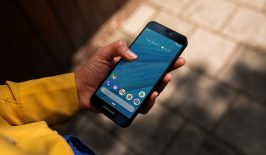The world of consumer tech doesn’t tend to have a big focus on sustainability. But this year’s IFA conference had a few promising developments on display – at least in one particular corner.
One of the interesting new trends at IFA 2019 in Berlin – Europe’s gigantic annual tech conference – was a push towards more sustainable options for protecting smartphones. Biodegradable and bioplastic cases, along with options that used materials in a more circular way, were on show from a number of new and diversifying consumer technology brands.
In many ways, IFA is sort of the anti-thesis to the sustainable ideal. 1,800 exhibitors enter the giant halls of the Messe complex in west Berlin, a pop-up event full of temporary constructions, plastics, metals, with thousands of people attending from all over the world, for just five days. Not to say that’s the creation of IFA, but the world of conferences we live in. And among the flyers being distributed and water bottles to keep hydrated, sustainability is often the last item on most company lists: just get it done, in a hurry.
But around the very edges, some things seem to be changing. At least three brands were proudly showing off variously more eco-friendly accessories for smartphones. SKECH and Wilma were two that new have created smartphone cases for iPhones or Android phones using biodegradable bioplastics. Both brands also had cardboard packaging for recycling or composting, both using soy inks to print their packaging, creating designs and colours only in line with the most earth-friendly options in order to make a one hundred percent biodegradable material (although only Wilma claimed to be certified biodegradable by European Standard EN 13432).
This is only one very small step, of course, (in a world flooded with plastic and discarded electronics) and the composition and degrading of the devices remains problematic, as Pärlan Fritz, commercial director at Swedish company FashionTekk, behind the eco-friendly brand, Wilma, admitted..
“Wilma cases are made from PLA, which is a plant-based composition material derived from starch and different parts of the vegetable, fruit or wheat,” said Frtiz. “But this is almost the beginning of the evolution. We have people working on what can we do next to take this further.”
This plant-based plastic, as well as still being a plastic, also therefore comes from crops that need to be planted, meaning land may have to be cleared to plant them. And the issue of how to understand what biodegradable means was another point raised. The issue for many is that calling this type of product “biodegradable” makes it sound like tossing a biodegradable product into the trash or into a forest will mean it disappears in a matter of months. But biodegradability, in Europe, falls to an EU standard: EN 13432. What this actually means is that bioplastics will only break down via industrial composting plants, where heat is generated from isolated organic materials breaking down. If a biodegradable plastic enters a waterway, it doesn’t melt away: just like other plastics it floats as trash, eventually breaking down into microplastics.
“The heat is then a very very big part of why it is actually biodegrading, at a good speed, so to speak. It’s dependent on the circumstances – you shouldn’t just put a case out somewhere out into the woods. You have to compost it under good conditions, then it will biodegrade,” Fritz explained. “When you have the right heat conditions, it degrades within around six to 12 months. And then it comes earth.”
New concept Muvit took things one step further, offering smartphones cases made from bamboo, but also focusing on disrupting the production of as-yet non-recyclable and notoriously excessively-produced (seriously, who doesn’t somehow have 5 in a drawer somewhere at home?) smartphone chargers in new ways. Existing chargers are problematic; made from moulded plastic and metal, they’re pretty much impossible to re-use once they reach the end of their useful life.
Muvit’s coming range, however, was created entirely from recycled plastics, and designed in a modular way so that you can take them apart and replace certain elements once their lifespan is over. I wasn’t able to take photos, but the designs looked just like a regular smartphone chargers, except with the addition of clear lines showing how they were put together and how they can be taken apart.
Okay, so eco-smartphone cases probably aren’t going to save the planet any day soon. In fact, Mmybe the biggest impact of these kind of smartphone cases will be to help to extend the life of smartphones (so that they can be dropped a few times without being completely destroyed and having to be replaced!) rather than in terms of the amount of plastic that they reduce. They will probably only ever make a tiny dent on the negative impact of the current throwaway culture of consumer electronics, but it’s interesting to see these kind of innovations being featured at such an event as the IFA. Maybe the ongoing success of ethically-produced smartphones such as Fairphone and the Shiftphone have made mainstream manufacturers sit up and realise that there are growing numbers of conscious consumers who want more eco-friendly alternatives. It’s certainly a (tiny) step in the right direction.






